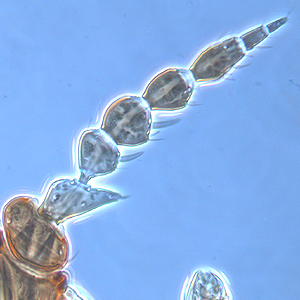Figures
Fig. 1: Antenna
Fig. 2: Head dorsal
Fig. 3: Pronotum
Fig. 4: Meso- and metanotum
of a macropterous female
Fig. 5: Meso- and metanotum of a brachypterous female
Fig. 6: Forewing and base of forewing with alula
Fig. 7: Tergites V and VI
Fig. 8: Tergites VIII-X
ITS-RFLP gel patterns (1&8 ladder, 2 PCR-product, 3 RSAI, 4 HaeIII, 5 MspI, 6 HinfI, 7 AluI)
Fig. 9: Primer pair CS249/CS250
Fig. 10: Primer pair O1/18J
Fig. 11: Primer pair P1/28Z
Taxonomic Information
Species:
Arorathrips mexicanus (Crawford DL, 1909)
Synonyms:
Chirothrips saltensis Tapia, 1952
Chirothrips
catchingsi Watson, 1924
Chirothrips floridensis Watson, 1920
Chirothrips mexicanus Crawford DL, 1909
Common name:
None established
Present taxonomic position:
Family: Thripidae Stephens, 1829
Subfamily: Thripinae (Stephens) Karny, 1921
Genus: Arorathrips Bhatti, 1990
Species Recognition
General information about the genus Arorathrips:This genus was originally included with genus Chirothrips however was elevated to it's current generic state by Bhatti in 1990. Mound and Marullo (1996) characterized the genus as having a reduced mesothoracic furca and in addition they report that all 13 species are from the New World.
Typical character states of Arorathrips mexicanus:
Body color
Mainly brown
Antennae
Number of antennal segments: 8
Segments II and III shape: Segment II with external margin strongly prolonged but not III
Segments III & IV sensoria: emergent and simple
Base of sensorium on antennal segment VI: no more than 2 times as wide as base of nearest seta
Terminal antennal segments: rarely elongate
Head:
Distance between bases of ocellar setae III: greater than width of first ocellus
Head shape between compound eyes: distinctly prolonged
Ocellar setae III on head: arising on anterior margin of, or in front of, ocellar triangle
Postocular setae I: present
Surface of head, pronotum and fore legs: without strong reticulate sculpture
Ocellar setae I in front of anterior ocellus: present
Prothorax
Number of pairs of elongate pronotal setae: 0-3
Number of pairs of elongate posteroangular pronotal setae: 2
Pronotum shape: trapezoid
Mesothorax
Mesothoracic endofurca: without median spinula
Metathorax
Metanotal median setae length: shorter than lateral metanotal setae
Metanotal median setae position: arising behind anterior margin
Metanotum: without campaniform sensilla
Metanotum major sclerite: with only one major sclerite, this is at least twice as wide as long or with two major sclerites, metascutum and metascutellum
Metanotum median area: with at least some equiangular reticulation or with no equiangular reticulation
Metanotum sculpture: without dominant sculptured triangle medially
Metathoracic endofurca: transverse, sometimes with simple median spinula
Wings
Wings: absent, or not longer than thorax width or present and more than half as long as abdomen
First vein of forewing: distinct from costal vein
Forewing anterior margin: with setae and cilia but cilia longer than setae
Forewing color: uniformly pale or weakly shaded
Forewing costal fringe of cilia: arising at anterior margin of wing
Forewing costal setae at middle of wing: shorter than median width of wing
Forewing first vein setal row: incomplete, with setae not closely and uniformly spaced
Forewing posterior margin cilia: undulated near apex
Forewing second vein setal row: incomplete, with setae not closely and uniformly spaced
Forewing surface: not reticulate
Forewings: with veins, setae and microtrichia
Legs
Fore tibial apex: extending laterally around first fore tarsal segment
Mid and hind tarsi: with two segments
Abdomen:
Abdominal pleurotergites: not covered in microtrichia
Abdominal segment X: never tubular, longitudinally incomplete ventrally in both sexes
Abdominal sternite II: with marginal setae but no discal setae
Abdominal sternite III of female: without glandular areas
Abdominal sternite VII: with marginal setae but no discal setae
Abdominal sternite VII median marginal setae: arising in front of margin
Abdominal sternites IV , V and VI: with marginal setae but no discal setae
Abdominal tergites: without curved wing-retaining setae
Abdominal tergites IV & V median setal pair: much shorter than distance between their bases
Abdominal tergites V-VII: without paired ctenidia, sometimes with irregular microtrichia
Number of discal setae on sternite V: 10-13
Setae on abdominal tergite X: slender
Surface of lateral thirds of abdominal tergites: without regular rows of fine microtrichia
Ctenidia on tergite VIII: not present, but groups of microtrichia
Biology
Life history:
As with other thrips species the life cycle from egg to adult is dependent on temperature. The full cycle can take less than one week to over a month and adults may live for more than one month producing several generations in one year depending on seasonal weather.
Host plants:
Grasses, Poaceae
Vector capacity:
None identified
Current known distribution:
In tropical and subtropical regions.
Additional notes:
Similar to Arorathrips carssiscelis Strassen found at quarantine inspections in North America but separated by the number of setae found on the head, e.g. Arorathrips mexicanus has 6-8 and Arorathrips carssiscelis has 10-18. This species is found living in grasses in tropical and subtropical regions. It has been known to decimate commercial grass seed production by laying eggs in grass florets where the larvae develop. This species is possibly spread as resting life stages within cultivated grass seeds when grasses are transported around the world.
Bibliography
Bhatti, JS (1990): On some genera
related to Chirothrips (Insecta: Terebrantia: Thripidae). - J. of Pure
and Applied Zoology 2: 193-200.
Moritz G, Morris DC, Mound LA (2001): ThripsID - Pest thrips of the world. ACIAR and CSIRO Publishing Collingwood, Victoria, Australia, CDROM ISBN 1 86320 296 X.
Moritz G, Mound LA, Morris DC, Goldarazena A (2004): Pest thrips of the world - an identification and information system using molecular and microscopial methods. CBIT, University of Queensland,CDROM ISBN 1-86499-781-8.
Mound, LA & Marullo, R (1996): The thrips of Central
and South America: An Introduction (Insecta: Thysanoptera). Associated
Publishers, Gainesville.
Mound, LA & Kibby, G (1998): Thysanoptera: An identification
guide, (2nd edition). CAB International, Wallingford and New York, 70pp.
Links:
Mound, LA (2005): Thysanoptera (Thrips) of the World
- A Checklist. http://www.ento.csiro.au/thysanoptera/worldthrips.html












